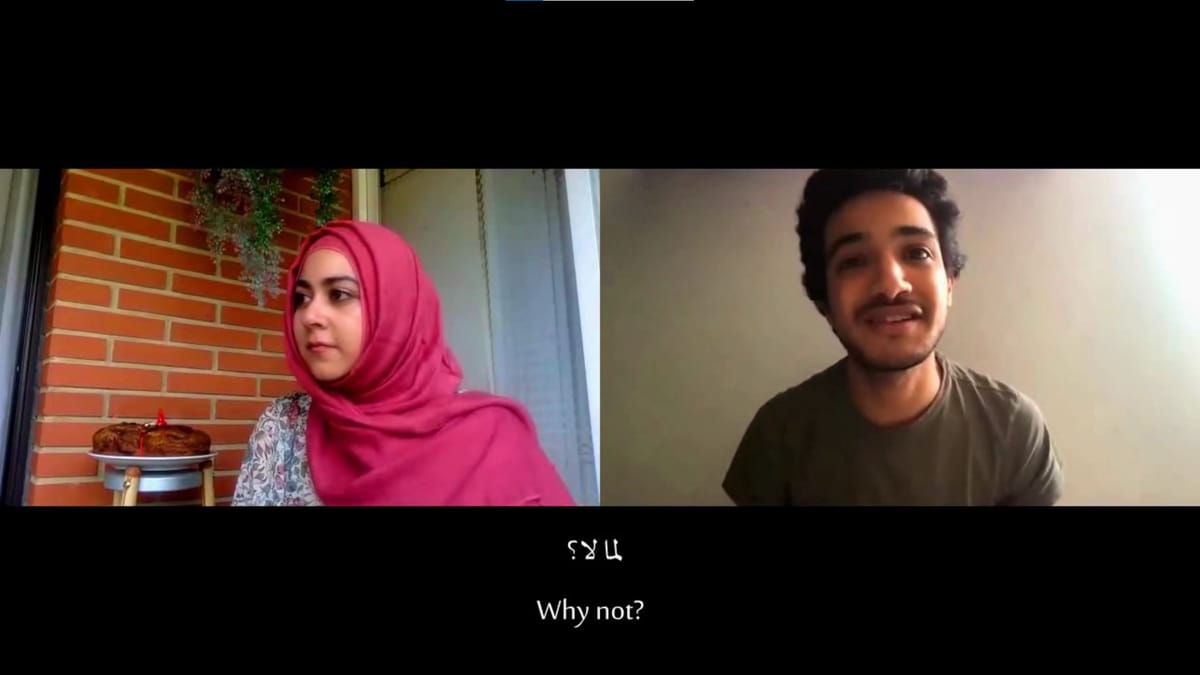‘What’s Left is Right’, or the dying hope of the Palestinian youth.

By Nadia Rabbaa, MSc Violence, Conflict & Development
Konrad Suder Chatterjee’s alien art form touches on the Israeli-Palestinian conflict in a too rarely spoken about way as it questions the lines between resistance and suicide. Despite its pervasive saviorism, there is bravery in opening the door of a conversation around children’s agency over their own death.
‘What’s Left is Right’ will leave the viewer with a lasting feeling of purposeful uneasiness. Shot in the middle of the Covid-19 pandemic and portrayed as an online video conversation, the play is a mise en abyme of our new normal. The digitised conversation between a mother, Leyla, and her imprisoned teenage son, Kareem, resonates deeply, with the exception that few of us can relate to life in a war-torn country. Chatterjee’s sensitivity picks up on something only an outsider would notice: the complex yet contradictory mix of despair and desensitisation that decades-long conflicts inflict on a population.
The play is a tale of a drift; of a tired hope being passed on to an already worn-out generation. Not seeing the end of the occupation, Kareem perceives the transmission of the fight for liberation as a burden. Reclaiming his agency, the 16 year old Palestinian wants to die – with or without the help of his mother. ‘Going home?! I don’t feel at home at all. I feel like I’m migrating between two prisons: the one here, indoors, in detention, and the one there, outdoors, in the village. I’m tired, mum, I’m tired…’ he pleads. Refusing the hyper glorified injunction of resistance, Kareem’s only freedom left is departure. The necropolitics of the State has reached its extreme when the only way to reclaim sovereignty over one’s body is by choosing one’s own death.
Chatterjee’s depiction of Israel as a carceral state, borrowed from a Foucauldian analysis of prison, is ubuesque in its depiction. Assisted suicide, or euthanasia, is illegal in Israel as it is in most of the countries form the region. Similarly, under no circumstances would a Palestinian prisoner be allowed access to a computer and internet. These elements of fiction might make Kareem’s story easier to comprehend for a foreign audience, but its white male gaze depletes it of its authenticity. A female Arab writer would probably have displayed a different sensitivity to the importance of cultural representation, as well as portrayed less stereotypical gender roles. Layla’s character reinforces the essentialization of women as loving and caring beings, while her expectations of her son to carry on the resistance reinforces the idea that men ought to be strong and fearless. Queering the characters by portraying a conversation between a father and his daughter, inspired by the real-life persona of Ahed Tamimi for instance, would have brought a more subtle understanding of the relationship between gender and violence.
The unquestionable worth of ‘What’s Left is Right’ however lies in its exploration of the complexity of childhood during warfare. Children are ‘the promise of a better future’ Layla says in the play. The figures presented by Chatterjee are dreadful: 10,000 Palestinian children have been detained by Israel in the past 20 years. They have experienced physical and verbal violence, humiliation, intimidation, and have been hand tied, blindfolded, detained from their homes in the middle of the night, not properly informed of their rights, and interrogated without the presence of a family member. What future does that leave Palestine with?
One could say that ‘What’s Left is Right’ isn’t merely a play. At the crossroads of art and activism, this first volume – the play is set as a trilogy – embodies a Malrausian stance in its imaginative form of political commitment. Despite a certain amateurism, the play’s objective, to highlight an intolerable situation – the imprisonment of Palestinian children – is a success. As war blurs categories between perpetrators and victims, ‘What’s Left is Right’ is resounding on the limits of resilience.
Photo caption: Conversation between a mother, Leyla, and her imprisoned teenage son, Kareem. (Credit: Nadia Rabbaa)


